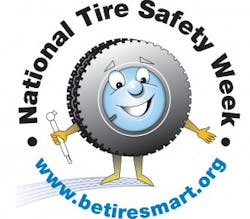Bendix offers 'Pressure Points' for National Tire Safety Week
Safe trucks make for safer roadways—and safe tires make for safer trucks. In support of National Tire Safety Week (May 29-June 4) and ahead of next week’s annual International Roadcheck, Bendix Commercial Vehicle Systems LLC offers four key “Pressure Points” as reminders of the importance of proper tire inflation.
The Rubber Manufacturers Association sponsors National Tire Safety Week as part of its year-round efforts to raise awareness of tire care and maintenance issues.
Safety
Underinflated tires undergo increased stress and experience higher temperatures, increasing the risk of failure. According to industry research, 90 percent of tire blowouts can be attributed to underinflation, and nearly half of all emergency service road calls are tire-related.
Correctly inflated tires also help to ensure the best performance of today’s most advanced commercial vehicle safety systems: Reduced Stopping Distance (RSD)-compliant brakes, full-stability, and collision mitigation systems are all optimized when the vehicle they’re protecting is running on properly maintained tires.
“Any component that can play a role in the vehicle’s stopping ability can find its performance hindered when tires aren’t kept at the proper pressure and in good working condition,” said Jon Intagliata, Bendix’s product manager for Tire Pressure Monitoring Systems (TPMS). “That’s why it’s so important to catch low-pressure situations quickly and remedy them the same day they are discovered.”
Reflecting the critical nature of tire pressure to safe operation, underinflated tires are also a violation in today’s Compliance, Safety, Accountability (CSA) inspection environment, which can impact a fleet’s CSA scoring.
Tire Temperature
Cost Savings
Because fuel and tires are typically among fleets’ largest expenses, maintaining the right tire pressure every day over miles and miles pays dividends in both fuel savings and tread life. Underinflation by as little as 10 percent can result in a 1.5 percent drop in fuel economy, according to research by the American Trucking Associations’ Technology & Maintenance Council (TMC), and underinflation by 20 percent results in a 30 percent reduction in tire life.
A TPMS can also address tire-related downtime costs: The real-time status information these systems provide to drivers or maintenance technicians both warns of tire problems before they pose a safety hazard, and also eliminates the need for manual pressure checks. Tire inspections and maintenance are made more efficient since terminal operators can tell in advance which tires may need pressure adjustment.
Big-Picture Planning
With the right equipment and organizational planning, fleets can sharpen their maintenance team’s scheduling and shape a fleet-wide tire strategy.
SafetyDirect from Bendix CVS – a web portal that allows fleet owners to analyze real-time, wirelessly transmitted safety information – connects to systems like SmarTire and provides tire pressures, temperatures, and alerts to the back office. This enables fleet maintenance teams to plan specific vehicle service in advance, while fleet managers can examine and consider factors such as tire replacement frequency, tire repair downtime, and occurrences of roadside breakdowns due to tire failure.
“There’s really no such thing as taking too much care when it comes to a truck’s tires,” Intagliata said. “So many aspects of safe vehicle operation – and, by extension, highway safety – depend on their maintenance and inspection. That’s why we’ll continue to work on developing and improving ways to keep fleets and drivers running on safe, properly inflated tires in all situations and conditions.”

